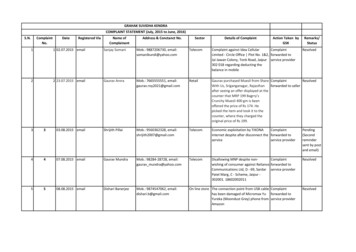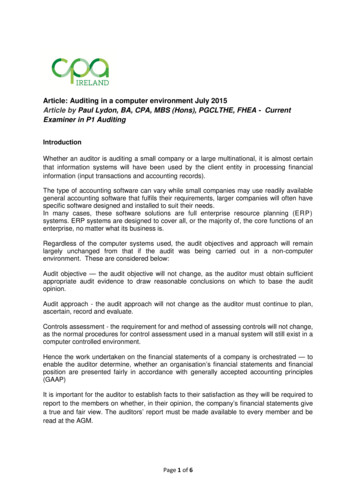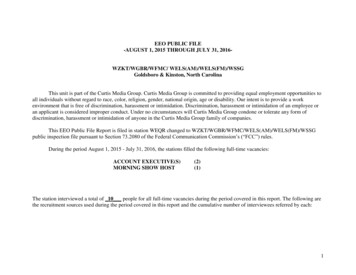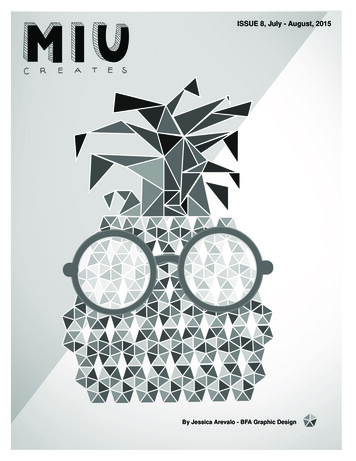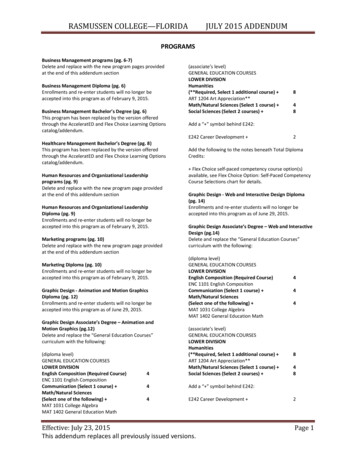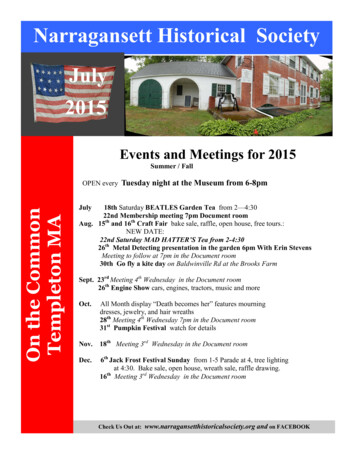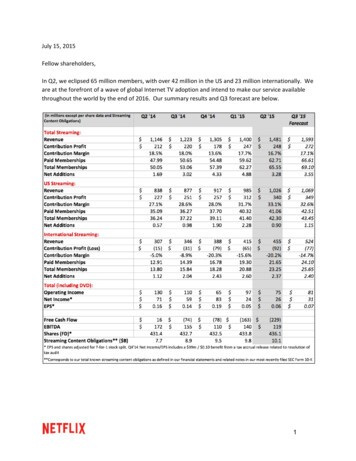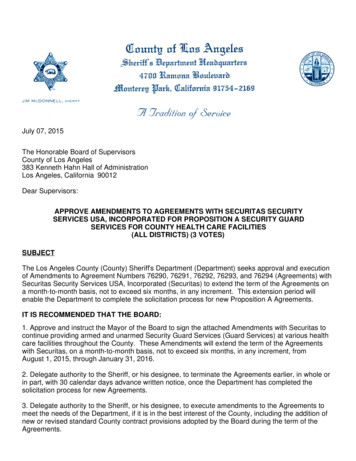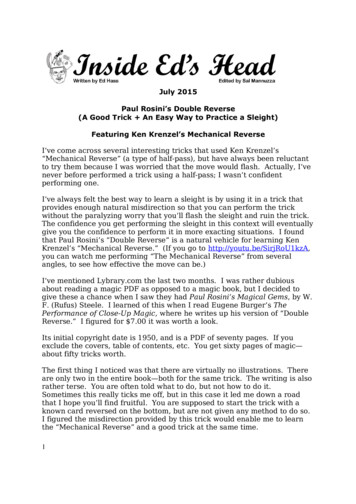
Transcription
July 2015Paul Rosini’s Double Reverse(A Good Trick An Easy Way to Practice a Sleight)Featuring Ken Krenzel’s Mechanical ReverseI’ve come across several interesting tricks that used Ken Krenzel’s“Mechanical Reverse” (a type of half-pass), but have always been reluctantto try them because I was worried that the move would flash. Actually, I’venever before performed a trick using a half-pass; I wasn’t confidentperforming one.I’ve always felt the best way to learn a sleight is by using it in a trick thatprovides enough natural misdirection so that you can perform the trickwithout the paralyzing worry that you’ll flash the sleight and ruin the trick.The confidence you get performing the sleight in this context will eventuallygive you the confidence to perform it in more exacting situations. I foundthat Paul Rosini’s “Double Reverse” is a natural vehicle for learning KenKrenzel’s “Mechanical Reverse.” (If you go to http://youtu.be/SirjRoU1kzA,you can watch me performing “The Mechanical Reverse” from severalangles, to see how effective the move can be.)I’ve mentioned Lybrary.com the last two months. I was rather dubiousabout reading a magic PDF as opposed to a magic book, but I decided togive these a chance when I saw they had Paul Rosini’s Magical Gems, by W.F. (Rufus) Steele. I learned of this when I read Eugene Burger’s ThePerformance of Close-Up Magic, where he writes up his version of “DoubleReverse.” I figured for 7.00 it was worth a look.Its initial copyright date is 1950, and is a PDF of seventy pages. If youexclude the covers, table of contents, etc. You get sixty pages of magic—about fifty tricks worth.The first thing I noticed was that there are virtually no illustrations. Thereare only two in the entire book—both for the same trick. The writing is alsorather terse. You are often told what to do, but not how to do it.Sometimes this really ticks me off, but in this case it led me down a roadthat I hope you’ll find fruitful. You are supposed to start the trick with aknown card reversed on the bottom, but are not given any method to do so.I figured the misdirection provided by this trick would enable me to learnthe “Mechanical Reverse” and a good trick at the same time.1
Once again, I’d like to thank Chris Wasshuber of Lybrary.com for allowingme to use the Rosini routine. I’d also like to thank Sal Mannuzza for takingthe photos for this issue.Double Reverse, by Paul RosiniEffect: The magician and the spectator each take about half the deck. Theyremove a card from their half and table it. The spectator’s card is insertedinto the magician’s half, the magician’s card is placed in the spectator’shalf. The deck is reassembled, and held by the spectator.Both call out the name of their card. The spectator spreads the deck, andboth cards are now face up.Method: Have the spectator shuffle the deck and cut off a little more thanhalf the cards. You then pick up those that are left. (It’s not essential thatyou take less than half the deck, but it makes the reverse a bit easier.)Tell the spectator that he must watch what you do carefully, for he is torepeat your actions. Spread the cards in front of you, holding them in a lefthand fan, backs to the spectator, ostensibly to find a card in the center ofthe spread. You should only pay attention to the face card of your packet.You must remember this card. It’s the one you will reverse.Stare at the spread of cards for a bit, then removeany card from the center and hold it in front ofyour eyes as you pretend to memorize it. (Photo 1)Don’t memorize this; you need to remember theface card. I’m embarrassed to say that there weretoo many practice sessions where I forgot tomemorize the right card.Photo 1You may say to the spectator, “Be sure to lock this card into your mind. Ifeither of us forgets his card, we have no trick.” After a suitable amount oftime, table the card face down. Ask the spectator to pick up his half of thedeck, decide on a card, memorize it and table it as you have just done.This will (I hope) give you sufficient misdirection to make the following twomoves. Of course if you want complete cover for the moves just say, “Toassure you that I won’t try to peek at your card, I’ll just turn around.” Ifyour spectator can spot the reverse with your back turned to him, yourdemeanor is waaaaay too transparent.2
Ken Krenzel’s Mechanical Reverse: Close upthe spread of cards in an unsquared packet in theleft hand, the face card (Ace of Spades in Photo 2)should be slightly side-jogged to the right. Yourright hand now comes over the top of the packet tosquare it. As you do so, insert the tip of your leftlittle finger underneath the face card. (Photo 3)Your right thumb will end up at the lower leftPhoto 2corner of the packet, and your right middle fingerwill be at the top left corner. (Photo 4)Photo 3Photo 4Using your right hand, pivot the packet around itsright side, extending your left fingers so it ends upface down. Your pinky remains in the break, whichis now on the left side of the packet. (Photo 5.)Your right hand returns to Biddle grip. Note: I tryto take this grip as close to the ends of the rightfingertips as possible, to give as much clearance tothe reverse that’s to follow. (Photo 6.)Photo 5, Right Hand RemovedPhoto 6Your left hand lifts all the cards above the break somewhat up and to theleft. As you do this, you curl the left index, middle and ring fingers into3
your palm, reversing the card under the packet. I find the move works thesmoothest when I use my left index finger to initiate the move. (Photos 7and 8)Photo 7Photo 8Continue squaring with your right hand. Congratulations! You’ve justcompleted the reverse—but you’re not done yet. You have to turn thepacket over. (Be sure to see the section on Angle Problems at the end ofthis article.)If the spectator’s attention is still elsewhere, you can just continue youraction or the Mechanical Reverse by rotating the packet up and over bypulling up and to the right with your right index finger and thumb whilepulling down and to the left with your left fingers. (Photos 9 and 10)Photo 9Photo 10If you feel you need a better cover for theturnover, you can use the following move.Photo 114Reach over to the spectator’s face-down card, andslide it towards yourself. As you do so, you’ll begina “Tenkai Turnover” by dropping your left hand toyour side (if standing), or relaxing your hand, palmdown, on the table “off stage,” if sitting. (Photo11.)
Now slide your card over to the spectator and say,“Please put your right hand on my card until we’reready to use it.” As they do this, turn your lefthand palm down, and take the packet into yourright hand, thumb on top, fingers underneath.(Photo 12) Make a squaring gesture along thesides of the packet with your left fingers, and thenreplace the packet in left-hand mechanic’s grip.Photo 12Use your left thumb to bevel the cards at the upperleft corner. You can make a surprisingly largebevel without exposing the fact that the cards arereally face up. (Photo 13)Pick up the spectator’s card and insert it face downinto your packet. Carefully begin squaring thepacket at the inner and outer ends and then askPhoto 13the spectator to place your card face down into hispacket. As he does this you must turn over your packet once again. Moveyour left thumb under your packet and flip it over. Your right fingers maskthis action with the right hand continuing their squaring action. (Photo 14.)Photo 14Once the spectator has inserted your card fully into his packet, place yourpacket on top of his, and ask him to hold it tightly. Tell him, “On the countof three, I’m going to call out the name of my card. Please name your cardas I do so.” Make the count, and then call out the card you reversed. Thespectator will do likewise.All that’s left to do is ask the spectator to spread the cards. He’ll see hiscard and your card, both appearing face up in the deck.As I mentioned, you can do the secret moves with you back turned to thespectator. You might wonder, why not just “openly” turn the card over, andthen the packet. It’s just to get you used to doing the reverse and theturnover. Once you’re comfortable doing the trick and the sleights, youmight eventually stop turning your back, and do the moves with the natural5
misdirection supplied. Once you’ve mastered the reverse under thesecircumstances you might try some other tricks that use a reverse.You should also be aware that the “Krenzel Mechanical Reverse” can beused for any number of cards. If you need to “face” a deck, this is anexcellent move to do it. You can do any trick that requires a half-pass withthis reverse, as long as you have a reason to turn the deck over.Angle ProblemsThis move is not fool-proof. It works perfectly if you’re standing with aspectator to your right, or directly in front of you. Spectators to your leftwill definitely see the move if they are not misdirected. If you are workingto several people, face the leftmost one, and you’ll not have any problems.You can do this standing at a table—you just have to be careful to loweryour hands so the back of your right hand is interrupting the spectator’ssight line. Again, you must guard the left side.You can’t do this seated at a table with a spectator across the table. Thetable top will stop you from lowering your hands sufficiently to block theperson’s line of sight.I must say I was skeptical of this move at first. Extensive videotaping ledme to change my mind. I’ve performed this standing, with people seated ata table, to excellent results. I worked to the person to my left, and had notroubles.ReferencesCard Classics of Ken Krenzel, by Harry Lorayne, p. 207.Card College 4, by Roberto Giobbi, p. 991Complete works of Derek Dingle, by Richard Kaufman, p. 27Drawing Room Deceptions, by Guy Hollingworth, p. 256Ken Krenzel's Close-Up Impact, by Ken Krenzel, p. 61Ken Krenzel's Ingenuities, by Ken Krenzel, p. 61Workers 5, by Michael Close, p. 30Next time: Something out of the ordinary.Copyright 2015 by Edward Hass.Feel free to link to this article at:www.edhassmagic.com/eds-head.6
1 July 2015 Paul Rosini’s Double Reverse (A Good Trick An Easy Way to Practice a Sleight) Featuring Ken Krenzel’s Mechanical Reverse I’ve come across several interesting tricks that used Ken Krenzel’s


